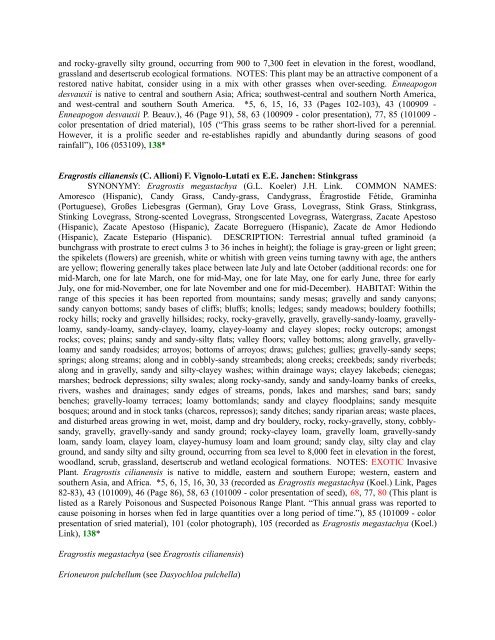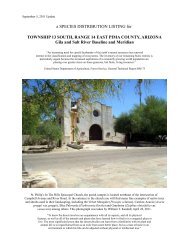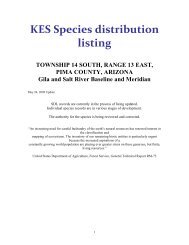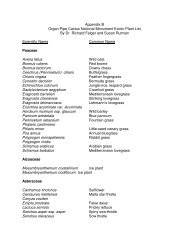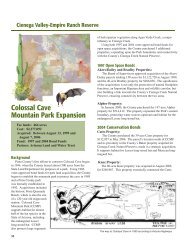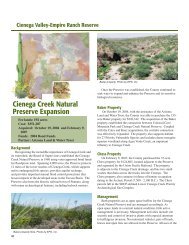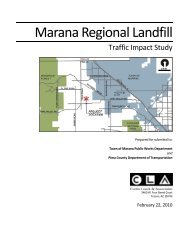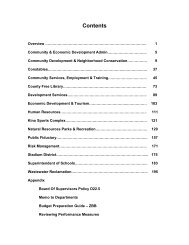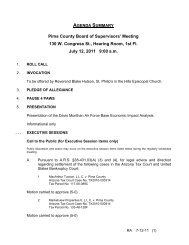Le Jardin de Mère Nature dans une Petite Planète - Pima County
Le Jardin de Mère Nature dans une Petite Planète - Pima County
Le Jardin de Mère Nature dans une Petite Planète - Pima County
Create successful ePaper yourself
Turn your PDF publications into a flip-book with our unique Google optimized e-Paper software.
and rocky-gravelly silty ground, occurring from 900 to 7,300 feet in elevation in the forest, woodland,<br />
grassland and <strong>de</strong>sertscrub ecological formations. NOTES: This plant may be an attractive component of a<br />
restored native habitat, consi<strong>de</strong>r using in a mix with other grasses when over-seeding. Enneapogon<br />
<strong>de</strong>svauxii is native to central and southern Asia; Africa; southwest-central and southern North America,<br />
and west-central and southern South America. *5, 6, 15, 16, 33 (Pages 102-103), 43 (100909 -<br />
Enneapogon <strong>de</strong>svauxii P. Beauv.), 46 (Page 91), 58, 63 (100909 - color presentation), 77, 85 (101009 -<br />
color presentation of dried material), 105 (“This grass seems to be rather short-lived for a perennial.<br />
However, it is a prolific see<strong>de</strong>r and re-establishes rapidly and abundantly during seasons of good<br />
rainfall”), 106 (053109), 138*<br />
Eragrostis cilianensis (C. Allioni) F. Vignolo-Lutati ex E.E. Janchen: Stinkgrass<br />
SYNONYMY: Eragrostis megastachya (G.L. Koeler) J.H. Link. COMMON NAMES:<br />
Amoresco (Hispanic), Candy Grass, Candy-grass, Candygrass, Éragrosti<strong>de</strong> Féti<strong>de</strong>, Graminha<br />
(Portuguese), Großes Liebesgras (German), Gray Love Grass, Lovegrass, Stink Grass, Stinkgrass,<br />
Stinking Lovegrass, Strong-scented Lovegrass, Strongscented Lovegrass, Watergrass, Zacate Apestoso<br />
(Hispanic), Zacate Apestoso (Hispanic), Zacate Borreguero (Hispanic), Zacate <strong>de</strong> Amor Hediondo<br />
(Hispanic), Zacate Estepario (Hispanic). DESCRIPTION: Terrestrial annual tufted graminoid (a<br />
bunchgrass with prostrate to erect culms 3 to 36 inches in height); the foliage is gray-green or light green;<br />
the spikelets (flowers) are greenish, white or whitish with green veins turning tawny with age, the anthers<br />
are yellow; flowering generally takes place between late July and late October (additional records: one for<br />
mid-March, one for late March, one for mid-May, one for late May, one for early J<strong>une</strong>, three for early<br />
July, one for mid-November, one for late November and one for mid-December). HABITAT: Within the<br />
range of this species it has been reported from mountains; sandy mesas; gravelly and sandy canyons;<br />
sandy canyon bottoms; sandy bases of cliffs; bluffs; knolls; ledges; sandy meadows; boul<strong>de</strong>ry foothills;<br />
rocky hills; rocky and gravelly hillsi<strong>de</strong>s; rocky, rocky-gravelly, gravelly, gravelly-sandy-loamy, gravellyloamy,<br />
sandy-loamy, sandy-clayey, loamy, clayey-loamy and clayey slopes; rocky outcrops; amongst<br />
rocks; coves; plains; sandy and sandy-silty flats; valley floors; valley bottoms; along gravelly, gravellyloamy<br />
and sandy roadsi<strong>de</strong>s; arroyos; bottoms of arroyos; draws; gulches; gullies; gravelly-sandy seeps;<br />
springs; along streams; along and in cobbly-sandy streambeds; along creeks; creekbeds; sandy riverbeds;<br />
along and in gravelly, sandy and silty-clayey washes; within drainage ways; clayey lakebeds; cienegas;<br />
marshes; bedrock <strong>de</strong>pressions; silty swales; along rocky-sandy, sandy and sandy-loamy banks of creeks,<br />
rivers, washes and drainages; sandy edges of streams, ponds, lakes and marshes; sand bars; sandy<br />
benches; gravelly-loamy terraces; loamy bottomlands; sandy and clayey floodplains; sandy mesquite<br />
bosques; around and in stock tanks (charcos, repressos); sandy ditches; sandy riparian areas; waste places,<br />
and disturbed areas growing in wet, moist, damp and dry boul<strong>de</strong>ry, rocky, rocky-gravelly, stony, cobblysandy,<br />
gravelly, gravelly-sandy and sandy ground; rocky-clayey loam, gravelly loam, gravelly-sandy<br />
loam, sandy loam, clayey loam, clayey-humusy loam and loam ground; sandy clay, silty clay and clay<br />
ground, and sandy silty and silty ground, occurring from sea level to 8,000 feet in elevation in the forest,<br />
woodland, scrub, grassland, <strong>de</strong>sertscrub and wetland ecological formations. NOTES: EXOTIC Invasive<br />
Plant. Eragrostis cilianensis is native to middle, eastern and southern Europe; western, eastern and<br />
southern Asia, and Africa. *5, 6, 15, 16, 30, 33 (recor<strong>de</strong>d as Eragrostis megastachya (Koel.) Link, Pages<br />
82-83), 43 (101009), 46 (Page 86), 58, 63 (101009 - color presentation of seed), 68, 77, 80 (This plant is<br />
listed as a Rarely Poisonous and Suspected Poisonous Range Plant. “This annual grass was reported to<br />
cause poisoning in horses when fed in large quantities over a long period of time.”), 85 (101009 - color<br />
presentation of sried material), 101 (color photograph), 105 (recor<strong>de</strong>d as Eragrostis megastachya (Koel.)<br />
Link), 138*<br />
Eragrostis megastachya (see Eragrostis cilianensis)<br />
Erioneuron pulchellum (see Dasyochloa pulchella)


